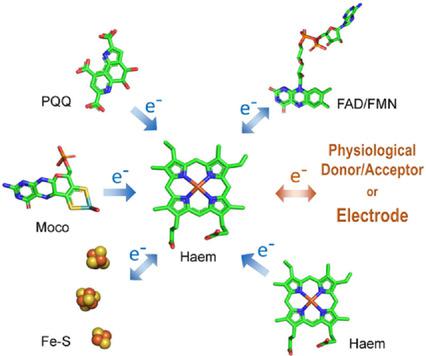当前位置:
X-MOL 学术
›
ChemElectroChem
›
论文详情
Our official English website, www.x-mol.net, welcomes your feedback! (Note: you will need to create a separate account there.)
Direct Electron Transfer of Enzymes Facilitated by Cytochromes
ChemElectroChem ( IF 4 ) Pub Date : 2018-12-13 , DOI: 10.1002/celc.201801256 Su Ma 1 , Roland Ludwig 1
ChemElectroChem ( IF 4 ) Pub Date : 2018-12-13 , DOI: 10.1002/celc.201801256 Su Ma 1 , Roland Ludwig 1
Affiliation

|
The direct electron transfer (DET) of enzymes has been utilized to develop biosensors and enzymatic biofuel cells on micro‐ and nanostructured electrodes. Whereas some enzymes exhibit direct electron transfer between their active‐site cofactor and an electrode, other oxidoreductases depend on acquired cytochrome domains or cytochrome subunits as built‐in redox mediators. The physiological function of these cytochromes is to transfer electrons between the active‐site cofactor and a redox partner protein. The exchange of the natural electron acceptor/donor by an electrode has been demonstrated for several cytochrome carrying oxidoreductases. These multi‐cofactor enzymes have been applied in third generation biosensors to detect glucose, lactate, and other analytes. This review investigates and classifies oxidoreductases with a cytochrome domain, enzyme complexes with a cytochrome subunit, and covers designed cytochrome fusion enzymes. The structurally and electrochemically best characterized proponents from each enzyme class carrying a cytochrome, that is, flavoenzymes, quinoenzymes, molybdenum‐cofactor enzymes, iron‐sulfur cluster enzymes, and multi‐haem enzymes, are featured, and their biochemical, kinetic, and electrochemical properties are compared. The cytochromes molecular and functional properties as well as their contribution to the interdomain electron transfer (IET, between active‐site and cytochrome) and DET (between cytochrome and electrode) with regard to the achieved current density is discussed. Protein design strategies for cytochrome‐fused enzymes are reviewed and the limiting factors as well as strategies to overcome them are outlined.
中文翻译:

细胞色素促进酶的直接电子转移
酶的直接电子转移(DET)已被用来开发微米和纳米结构电极上的生物传感器和酶生物燃料电池。虽然一些酶在其活性位点辅因子和电极之间表现出直接电子转移,但其他氧化还原酶依赖于获得的细胞色素结构域或细胞色素亚基作为内置氧化还原介体。这些细胞色素的生理功能是在活性位点辅因子和氧化还原伙伴蛋白之间转移电子。几种携带氧化还原酶的细胞色素已证实通过电极进行天然电子受体/供体的交换。这些多辅因子酶已应用于第三代生物传感器来检测葡萄糖、乳酸和其他分析物。本综述对具有细胞色素结构域的氧化还原酶、具有细胞色素亚基的酶复合物进行了研究和分类,并涵盖了设计的细胞色素融合酶。对携带细胞色素的每个酶类(即黄素酶、醌酶、钼辅因子酶、铁硫簇酶和多血红素酶)进行结构和电化学方面最有表征的支持者,以及它们的生化、动力学和电化学属性进行比较。讨论了细胞色素的分子和功能特性以及它们对域间电子转移(IET,活性位点和细胞色素之间)和DET(细胞色素和电极之间)的贡献以及所获得的电流密度。回顾了细胞色素融合酶的蛋白质设计策略,并概述了限制因素以及克服这些因素的策略。
更新日期:2018-12-13
中文翻译:

细胞色素促进酶的直接电子转移
酶的直接电子转移(DET)已被用来开发微米和纳米结构电极上的生物传感器和酶生物燃料电池。虽然一些酶在其活性位点辅因子和电极之间表现出直接电子转移,但其他氧化还原酶依赖于获得的细胞色素结构域或细胞色素亚基作为内置氧化还原介体。这些细胞色素的生理功能是在活性位点辅因子和氧化还原伙伴蛋白之间转移电子。几种携带氧化还原酶的细胞色素已证实通过电极进行天然电子受体/供体的交换。这些多辅因子酶已应用于第三代生物传感器来检测葡萄糖、乳酸和其他分析物。本综述对具有细胞色素结构域的氧化还原酶、具有细胞色素亚基的酶复合物进行了研究和分类,并涵盖了设计的细胞色素融合酶。对携带细胞色素的每个酶类(即黄素酶、醌酶、钼辅因子酶、铁硫簇酶和多血红素酶)进行结构和电化学方面最有表征的支持者,以及它们的生化、动力学和电化学属性进行比较。讨论了细胞色素的分子和功能特性以及它们对域间电子转移(IET,活性位点和细胞色素之间)和DET(细胞色素和电极之间)的贡献以及所获得的电流密度。回顾了细胞色素融合酶的蛋白质设计策略,并概述了限制因素以及克服这些因素的策略。



























 京公网安备 11010802027423号
京公网安备 11010802027423号